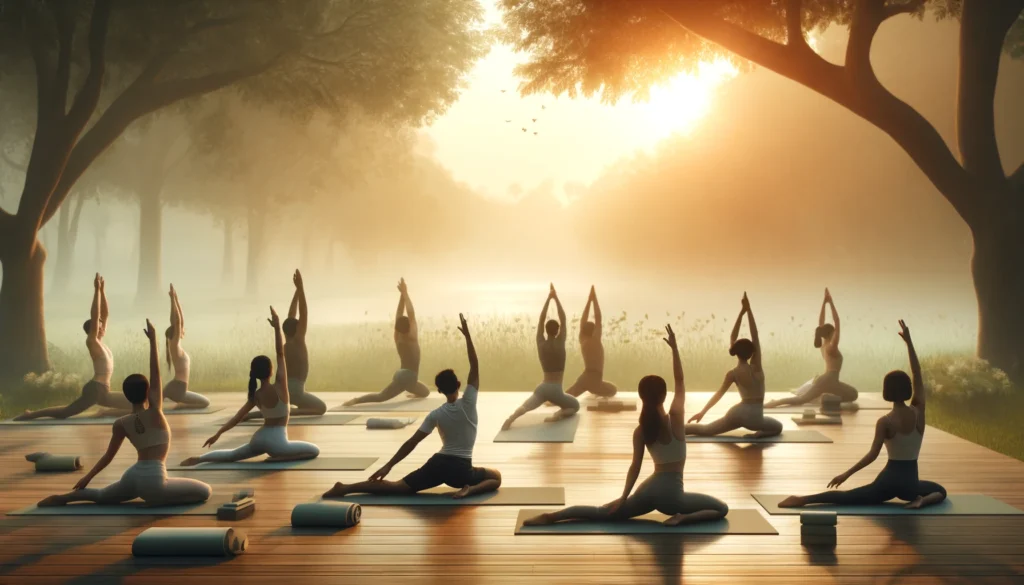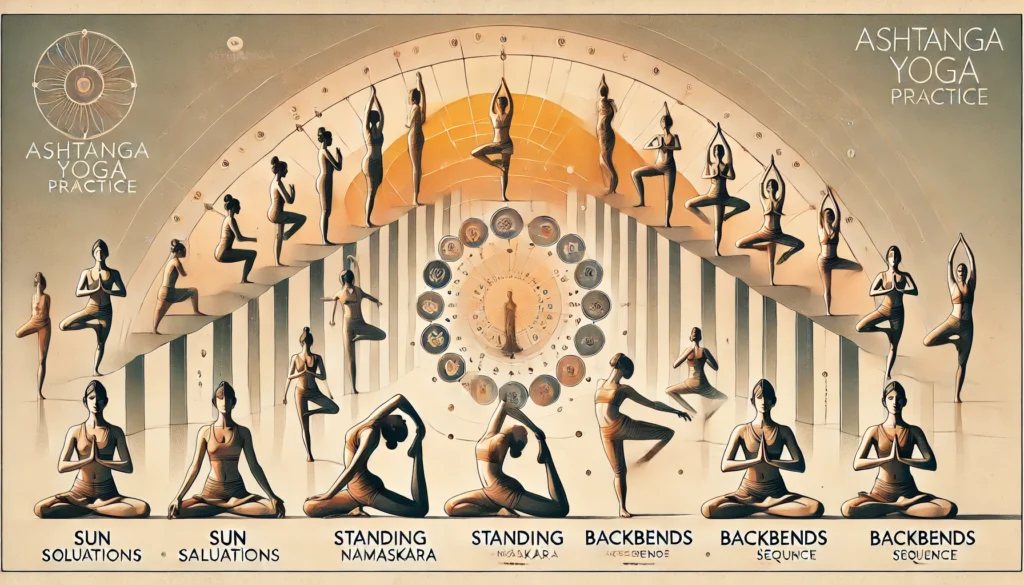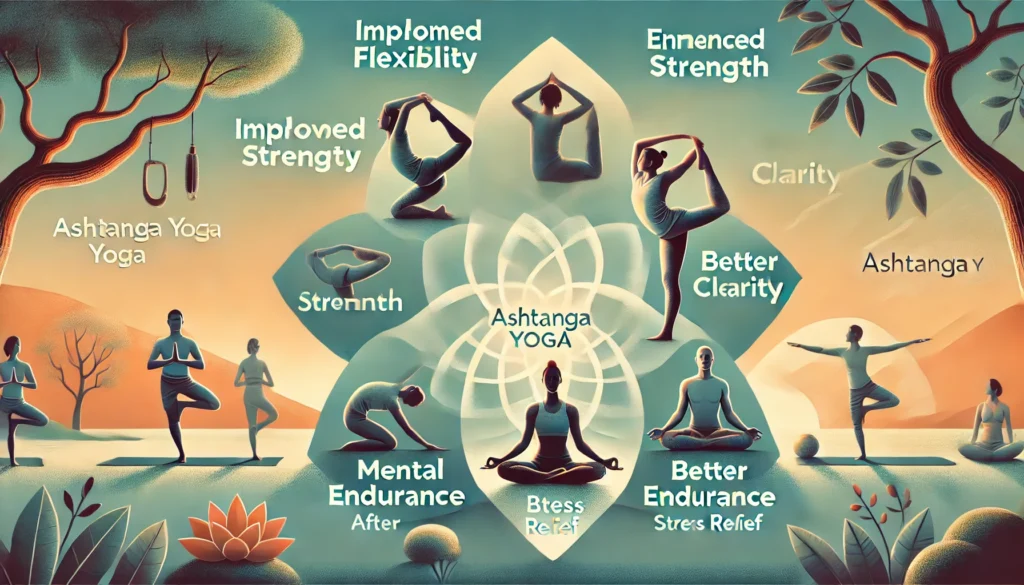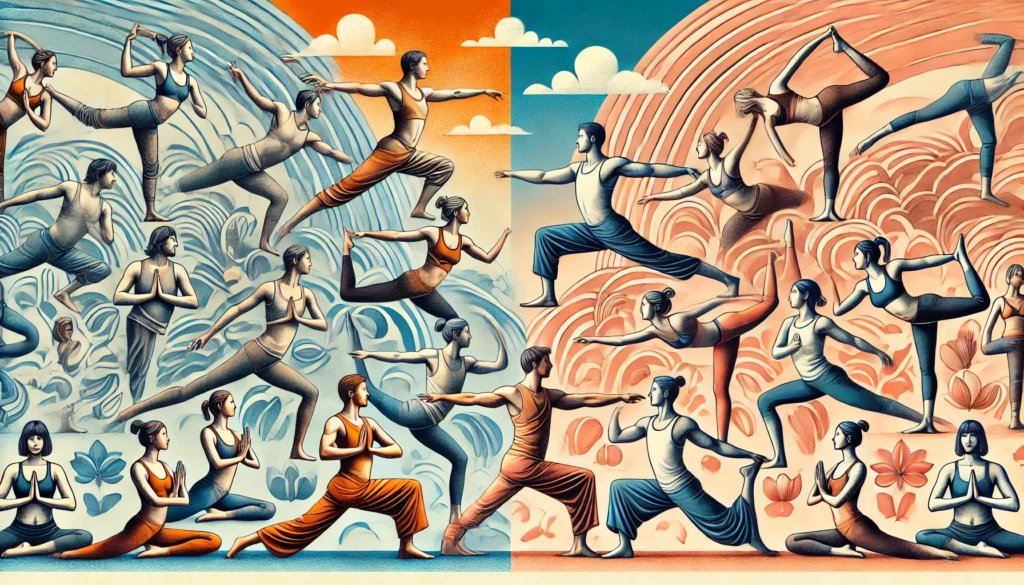Table of Contents
Introduction
Ashtanga Yoga is one of the most structured and disciplined forms of yoga, revered for its ability to build strength, improve flexibility, and cultivate mindfulness.
Originating from the teachings of the great sage Pattabhi Jois, Ashtanga Yoga follows a rigorous system of postures and breath control, making it a physically demanding yet deeply rewarding practice.
This dynamic yoga style is based on an eight-limbed path, which provides a holistic approach to achieving spiritual, mental, and physical well-being.
If you are looking to build yoga discipline and integrate a practice that enhances both body and mind, Ashtanga Yoga might be the perfect fit for you. Let’s dive deeper into this transformative practice.
What is Ashtanga Yoga?
Ashtanga is a vinyasa-based yoga style that synchronizes breath with movement. The term “Ashtanga” means “eight limbs” in Sanskrit, referring to the eight-fold path described in Patanjali’s Yoga Sutras. These eight limbs are:
- Yama (Ethical Disciplines) – Non-violence, truthfulness, non-stealing, celibacy, non-possessiveness.
- Niyama (Self-Discipline) – Purity, contentment, discipline, self-study, surrender to the higher self.
- Asana (Postures) – The physical practice of yoga postures.
- Pranayama (Breath Control) – Techniques like Ujjayi breathing to regulate energy.
- Pratyahara (Withdrawal of Senses) – Detachment from distractions.
- Dharana (Concentration) – Focus on a single point.
- Dhyana (Meditation) – Sustained concentration.
- Samadhi (Enlightenment) – Ultimate state of spiritual bliss.
While the physical practice of Ashtanga Yoga is the most well-known aspect, it is deeply rooted in spiritual discipline and mindfulness.

The Structure of Ashtanga Yoga Practice
Ashtanga Yoga is divided into six progressive series:
- Primary Series (Yoga Chikitsa) – Detoxifies and aligns the body.
- Intermediate Series (Nadi Shodhana) – Cleanses the nervous system.
- Advanced Series (Sthira Bhaga) – Builds strength, flexibility, and grace.
Each session follows a set sequence of Ashtanga yoga poses, beginning with Surya Namaskara (Sun Salutations A & B), followed by standing, seated, and finishing postures. The key elements that differentiate Ashtanga Yoga from other styles are:
- Ujjayi breathing – A deep, rhythmic breath that maintains energy and focus.
- Bandhas (energy locks) – Engagement of specific muscle groups to control energy flow.
- Drishti (gaze points) – Fixed gaze points to enhance concentration and balance.


Ashtanga Yoga Benefits
Practicing Ashtanga consistently offers a multitude of benefits:
- Physical Strength and Flexibility – The dynamic movements build muscle strength and improve overall flexibility.
- Improved Focus and Concentration – Through Drishti (gaze points) and breath awareness, Ashtanga fosters deep concentration.
- Detoxification – The intense movements and Ujjayi breathing stimulate circulation and detoxify the body.
- Weight Loss and Endurance – The fast-paced nature of Ashtanga makes it an effective practice for burning calories and increasing stamina.
- Mental Clarity and Stress Reduction – The focus on breath and movement brings about a meditative state, reducing anxiety and stress.
- Enhanced Cardiovascular Health – The rigorous nature of Ashtanga improves heart function and lung capacity.
- Improved Posture and Core Strength – Engaging the Bandhas (energy locks) helps in strengthening the core and maintaining good posture.
- Greater Self-Awareness – The deep connection between breath and movement enhances self-awareness and inner peace.


Common Challenges & How to Overcome Them
While Ashtanga is rewarding, it also comes with challenges:
- Intensity and Discipline – The structured sequences require patience and dedication. Start slowly and be consistent.
- Physical Strain and Injuries – Always warm up, listen to your body, and modify postures when necessary.
- Staying Motivated – Practice in a Mysore-style class where students progress at their own pace under a teacher’s guidance.
- Memorizing the Sequence – The fixed sequence can be overwhelming at first. Practicing regularly and breaking it down into sections can help.
- Building Endurance – Initially, the practice may feel exhausting. Gradually increasing session duration will help build stamina.
Ashtanga Yoga for Beginners: Tips to Get Started
If you are new to Ashtanga, here are some essential tips:
- Start with the Basics – Learn Surya Namaskara (Sun Salutations) before moving to complex poses.
- Focus on Breath Control – Master Ujjayi breathing to maintain a steady practice.
- Be Patient – Progress takes time; focus on alignment rather than speed.
- Attend a Mysore Class – This allows you to develop at your own pace with personalized guidance.
- Consistency is Key – Aim for at least 3–4 sessions per week to see progress.
- Use Props if Needed – Blocks and straps can assist in achieving proper alignment in poses.
- Hydrate and Nourish Your Body – Eating a balanced diet and staying hydrated supports endurance and flexibility.
Ashtanga Yoga vs. Other Yoga Styles
How does Ashtanga compare to other forms of yoga?
- Ashtanga vs. Hatha Yoga – Hatha is slow-paced and great for beginners, while Ashtanga is more intense.
- Ashtanga vs. Vinyasa Yoga – Both are flow-based, but Vinyasa is more flexible in sequencing, whereas Ashtanga follows a fixed sequence.
- Ashtanga vs. Power Yoga – Power Yoga is derived from Ashtanga but focuses more on fitness rather than tradition.
- Ashtanga vs. Iyengar Yoga – Iyengar focuses on precision and alignment with props, whereas Ashtanga emphasizes fluid movement and breath control.


How to Incorporate Ashtanga Yoga into Daily Life
- Morning Practice – Practicing Yoga in the morning helps set a positive tone for the day.
- Mindful Eating – Complement your practice with a balanced diet rich in whole foods.
- Consistency Over Intensity – Even a short practice each day is beneficial.
- Meditation and Breathwork – Incorporate Ujjayi breathing throughout the day for calmness and focus.
- Yoga Journaling – Keeping a journal about your progress, challenges, and reflections can deepen your practice.
- Integrate Philosophy into Life – Apply the ethical principles (Yama and Niyama) in daily interactions.
Conclusion
Ashtanga is more than just a physical practice; it is a journey of self-discovery, discipline, and transformation.
With its structured approach, emphasis on breath, posture, and mindfulness, and deep-rooted philosophy, Ashtanga Yoga has the power to enhance your physical, mental, and spiritual well-being.
Whether you are a beginner or an experienced yogi, embracing the discipline of Ashtanga Yoga can lead to profound personal growth and a more balanced life.
